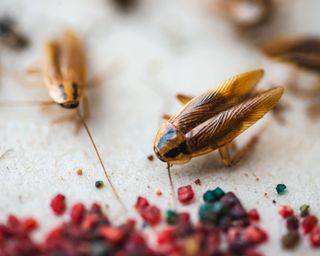

Using cockroach facts to bolster your pest control is a savvy way to weaponize millions of years of brilliant evolution against these pesky, persistent home invaders.
Fight Mother Nature with her own tricks, say our expert entomologists and professional pest exterminators, who have studied cockroach history, biology, behavior and everything in between to now reveal the three ways we can harness the very traits that help roaches survive, to boot them out of our homes for good.
Once you have identified the pest in your home, tackle roaches with the smartest tricks in the book — coming straight to you from the pros devising the cleverest ways to exterminate persistent roaches.
Household cockroach facts
They’re prehistoric

Learning how to get rid of cockroaches is straightforward enough, but the execution can prove trickier.
Entomologist Chad Gore, is an entomologist and market technical director for Terminix, responsible for training teams on exterminating roach infestations. He says, "There’s a lot to know about cockroaches with respect to their biology and behavior, but there's a good reason why they’re so successful and have been around relatively unchanged for several hundred millions years."
Chad explains how domestic and peri domestic cockroaches prefer to be hidden away to keep them safe from predators (that includes us humans). You can harness this evolutionary survival skill to ironically wipe out roaches from kitchens and other areas in your home.
Sprinkle a modest amount of boric acid in hideaway spots cockroaches are likely to run to for cover, including behind cabinets, under sofas, behind refrigerators, behind headboard and any cracks in flooring, fixtures, and walls.
This antibacterial insecticide powder is toxic to cockroaches, entering via their digestion system and killing them off.
We recommend the Zap-A-Roach Boric Acid Powder on Amazon Ant Killing Powder because of its pointed twist-top applicator bottle. The manufacturer's instructions say to twist open all the way but be wary of using too much powder.
You ideally want to attract unwanted roaches inhabitants to the powder, allowing them to digest or become covered in it, leading them to ingest when grooming themselves later. If you lay down too much powder, it will repel roaches and lead to them giving the insecticide a wide berth and surviving to scurry another day.
They feed at different rates

One of the most interesting behaviors in German cockroaches — the most common household roach in the United States — and one we can exploit in controlling them — is the differences in foraging and feeding rates between males and female, as well as the difference between older and young nymphs.
Chad explains, "Adult males forage and feed a lot, which makes them the most often captured in insect monitors. Adult females forage and feed a lot when they are not pregnant. They don’t forage or feed much at all when they are gravid.”
This means if you happen to kill or catch a pregnant female (their egg sack will be visible at their back end), that generally means your trap was close to a harborage (nest area) and there may be others nearby, helping you determine where to lay down more insecticide, extra traps or refocus your efforts.
“Older nymphs will forage and feed much more than very young nymphs, so if we catch really small nymphs, then we are likely near a harborage with others nearby,” explains Chad.
Use this knowledge to your advantage in your battle against roaches in your house by setting down traps such as the pesticide-free Harris Roach Traps from Walmart, which comes 10 traps per pack.
This is particularly important when ridding your kitchen of cockroaches (that includes cleaning your kitchen cabinets) as it’s a room with all the elements to help pests survive (food and water). It also has plenty of hiding spaces, making it tricky to eradicate these fast moving insects — unless you know where to focus your efforts, which luckily you now do.
Some cockroach species like the cold

Contrary to common perception, there are some roaches that prefer cold environments to the usual warm, humid spots we associate as cockroach havens.
Chad explains, “Whilst most cockroaches prefer warm, fairly humid environments, Oriental cockroaches are cold tolerant, which is why we see them in crawl spaces, basements, sub-slab, and other cooler environments.”
Identifying the species correctly will better help you find their hiding spots and know how to target them effectively.
Try cockroach bait gels such as Combat Max Roach Bait, available at Target, along cracks and crevices to lure them out from their sheltered positions.
"Roaches also prefer to be in close proximity to their food and water resources (which is often extremely diverse, since they’re omnivores). They basically require all of the same things as us (food, water, shelter)," adds Chad, so make sure you deep-clean your kitchen to eliminate these elements.
Meet the expert

Chad Gore, Ph.D., is an entomologist and Market Technical Director for Terminix, leading a team of Technical Services Managers with duties that include the development and continuous education of service technicians and managers, pest identifications, technical assistance during challenging pest problems, and development and delivery of training. While at NCSU, Chad worked on the physiological and molecular biology of German cockroach allergens, cockroach and allergen mitigation tactics in infested homes, and cockroach control in animal-rearing facilities.
Now you're on your way to getting your cockroach infestation under control, learn about the places you're forgetting to clean in the kitchen to make sure you catch all areas tempting for roaches to set up shop and avoid these pest control mistakes.
Join our newsletter
Get the best home decor ideas, DIY advice and project inspiration straight to your inbox!

Hi! I'm editor of Real Homes. I've been a senior journalist and editor for national magazines and newspapers for 16 years, specializing in consumer, real-life, and lifestyle articles. I have a BA in English Language and Communication, mentor journalists, and I’m also founding editor of Lacuna Voices, an independent digital platform. I love to cook, add character to my newly-built home, try my hand at DIY projects, keep my collection of plants alive, and make memories with my little family of three. For Real Homes, I specialize in articles on pest control, DIY, declutterring and cleaning, interviewing experts daily for their top tips and product recommendations.